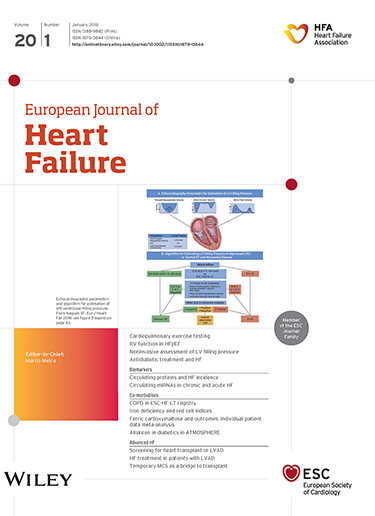Clustering in dilated cardiomyopathy at initial evaluation: An effective tool for clinical stratification.
IF 10.8
1区 医学
Q1 CARDIAC & CARDIOVASCULAR SYSTEMS
引用次数: 0
Abstract
AIMS Dilated cardiomyopathy (DCM) has a highly variable presentation and disease course. Current stratification strategies are complex and require multimodality evaluation. Using machine learning (ML) on a large dataset obtained at first cardiological evaluation, this study aims to identify specific DCM subgroups. METHODS AND RESULTS In a retrospective cohort of DCM patients, baseline clinical, genetic, and outcome data were collected. Unsupervised clustering was performed and then simplified to identify patient subgroups. The subgroups were characterized based on outcomes, including all-cause mortality/heart transplantation (HT)/left ventricular assist device implantation (LVAD), sudden cardiac death/major ventricular arrhythmias (SCD/MVA) and heart failure-related death/HT/LVAD. These findings were then validated in an external population. In the derivation cohort of 409 patients (mean age 46 ± 14 years, 71% male), two cluster-subgroups were identified: CL1 (82%) and CL2 (18%), mainly differentiated by electrocardiogram (ECG) characteristics. A lower yield of pathogenic/likely pathogenic variants was found in CL2 versus CL1 (15% vs. 47%, p < 0.001). A simplified clustering using only three variables (QRS duration, presence of left bundle branch block, intrinsicoid deflection >50 ms) was equally effective and validated in the external cohort of 160 patients (mean age 54 ± 13 years, 68% male). A lower risk for SCD/MVA events was observed for CL2 in the primary (hazard ratio 0.29, 95% confidence interval 0.13-0.67) and validation cohort (p = 0.017). CONCLUSIONS Using ML, baseline ECG variables were found to effectively identify two DCM subgroups differing in disease progression and genetic background. This approach could serve as a valuable tool for improving risk stratification of DCM patients upon their initial evaluation.初步评估扩张型心肌病的聚类:临床分层的有效工具。
目的扩张型心肌病(DCM)具有高度可变的表现和病程。目前的分层战略是复杂的,需要多模态评价。在首次心脏病评估中获得的大型数据集上使用机器学习(ML),本研究旨在确定特定的DCM亚组。方法和结果对DCM患者进行回顾性队列研究,收集基线临床、遗传和结局数据。进行无监督聚类,然后简化以识别患者亚组。亚组的特征基于结局,包括全因死亡率/心脏移植(HT)/左心室辅助装置植入(LVAD)、心源性猝死/主要室性心律失常(SCD/MVA)和心力衰竭相关死亡/HT/LVAD。这些发现随后在外部人群中得到了验证。在409例患者(平均年龄46±14岁,男性71%)的衍生队列中,确定了两个聚类亚组:CL1(82%)和CL2(18%),主要通过心电图(ECG)特征进行区分。在160例患者(平均年龄54±13岁,68%为男性)的外部队列中,发现CL2与CL1的致病性/可能致病性变异率较低(15%对47%,p 50 ms)同样有效。在主要队列(风险比0.29,95%可信区间0.13-0.67)和验证队列(p = 0.017)中观察到CL2发生SCD/MVA事件的风险较低。结论使用ML,发现基线心电图变量可有效识别疾病进展和遗传背景不同的两个DCM亚组。这种方法可以作为一种有价值的工具,用于改善DCM患者在初始评估时的风险分层。
本文章由计算机程序翻译,如有差异,请以英文原文为准。
求助全文
约1分钟内获得全文
求助全文
来源期刊

European Journal of Heart Failure
医学-心血管系统
CiteScore
27.30
自引率
11.50%
发文量
365
审稿时长
1 months
期刊介绍:
European Journal of Heart Failure is an international journal dedicated to advancing knowledge in the field of heart failure management. The journal publishes reviews and editorials aimed at improving understanding, prevention, investigation, and treatment of heart failure. It covers various disciplines such as molecular and cellular biology, pathology, physiology, electrophysiology, pharmacology, clinical sciences, social sciences, and population sciences. The journal welcomes submissions of manuscripts on basic, clinical, and population sciences, as well as original contributions on nursing, care of the elderly, primary care, health economics, and other related specialist fields. It is published monthly and has a readership that includes cardiologists, emergency room physicians, intensivists, internists, general physicians, cardiac nurses, diabetologists, epidemiologists, basic scientists focusing on cardiovascular research, and those working in rehabilitation. The journal is abstracted and indexed in various databases such as Academic Search, Embase, MEDLINE/PubMed, and Science Citation Index.
 求助内容:
求助内容: 应助结果提醒方式:
应助结果提醒方式:


